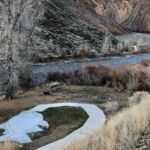History
Ghost towns of Custer, Bonanza, Bayhorse, old mining claims, and the behemoth gold dredge on the Yankee Fork are just a few of the many fascinating historical locations you can visit in the area. This area also offers many geological sights including the Challis Volcanics which is a geologic formation that preserves fossils dating back to the Paleogene period.
The Shoshone and Nez Perce peoples, who still fish traditional tribal waters, came to this area for the abundant hunting and fishing. See their remarkable relics and traces of their lives at the Buffalo Jump near Challis and pictograph sites along the Middle Fork.
The quest for beaver pelts brought Michel Bourdon and his fur trappers in 1822. Following the trappers were ranchers, cattlemen and traders who settled in the Challis area. Discovery of gold in 1873 west of Challis started a mining boom that lasted into the early 1900’s. These remote mining camps relied heavily on Challis for supplies. By driving the scenic Custer Motorway, you can trace the wagon trails where food and other necessary supplies were carried from Challis to the Yankee Fork Mining District.
In 1876, Alvah Challis platted the town of Challis, which became the supply depot for remote ranches and mining camps. The mining camps eventually became ghost towns, but Challis has flourished as the economic center for modern mining, ranching and recreation industries. Many of the original, historic buildings are still in use by local businesses along Main Street.
Explore more of Challis history by starting a walking tour at the North Custer Museum. Or visit the Land of the Yankee Fork State Park that has countless geological, mining, and other historical items and information about this beautiful area.





